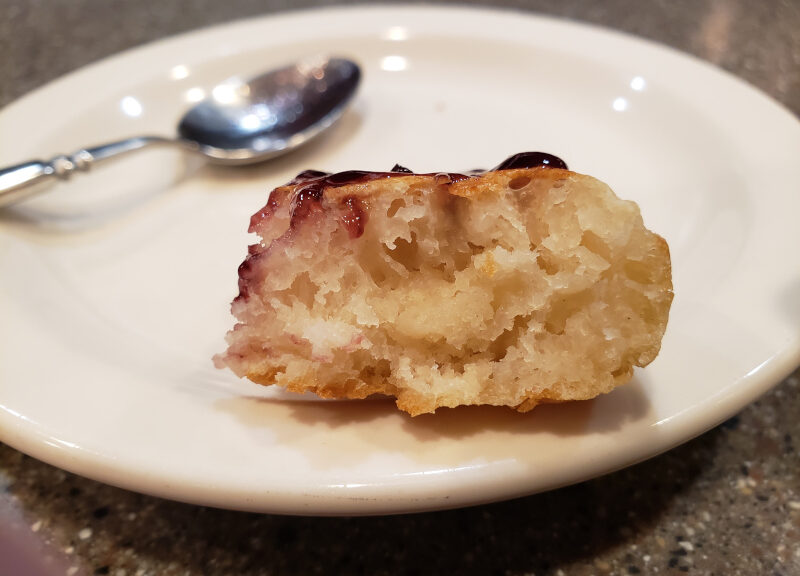I find crumpets a bit tricky, but in the past few weeks I’ve managed to learn how to turn out worthwhile crumpets every time. This post goes through my journey, and gives the recipe I’m using now.
Impatient? Jump to the recipe, below.
Frustrations
Having never made crumpets before, and being used to cooking American pancakes on a griddle, my big frustrations with crumpets continue to be 1) how long they take, and 2) how picky they are about their thickness. But take heart! I found good, home-made crumpets are worth the trouble.
I started out making very thin crumpets. Following the recipes I’d seen, I cooked them on the griddle at about 325° F (about 160° C). To my lights they took forever: the recipe that supposedly made 20 crumpets took me over 2 hours to cook! …and after the first hour the batter went flat. The result was thin, greasy, undercooked, and inedible.
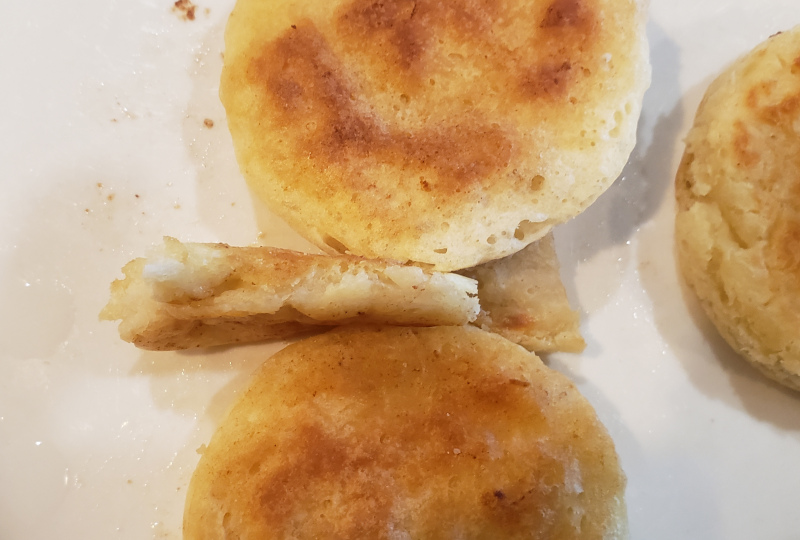
After a lot of research I found two helpful references: A Warburtons Crumpet recipe, released during the Covid-19 lockdowns, and the abstract of a paper, Crumpet Structures: Experimental and Modelling Studies.
The Warburtons recipe was a much more manageable size, making 8-12 crumpets per batch. The research paper held the crucial information that “structure has developed throughout around 75% of the product height within 30s”, and mentioned a hotter plate. For this reason many recipes recommend cooking the crumpets at a high temperature for one minute, then lowering the temperature to cook throughout.
After a few experimental batches, I settled on a temperature of 375° F (about 190° C), leaving it at that temperature throughout the cooking. I haven’t burned a crumpet yet, and they turn out very well.
The Recipe
Based on Warburtons’ “Our Iconic Crumpet Recipe Revealed“.
It yields about 8-10 crumpets, depending on how thick you pour the batter. Using the ice cream scoop I tend to get 8 crumpets from this recipe. NOTE: do not double the recipe unless you have a large enough griddle to cook half the crumpets in one go. Otherwise, I found the batter goes flat half way through.
It seems to take about 2 hours all told. That seems like a long time for just 8 crumpets, but they’re really good, and they freeze, so you can make several batches ahead of time.
Equipment
- 4-8 crumpet rings, depending on the size of your griddle.
- A medium mixing bowl
- A small cup for reviving the yeast
- A warm area to proof the batter, such as a toaster-oven that has a Proof setting
- A power mixer, such as a hand mixer
- Cling-Wrap (Cling-film)
- A griddle that holds at least 4 crumpet rings. I use a well-seasoned 9 inch (about 23 cm) square aluminum griddle, placed on a gas stovetop.
- Tongs, for removing the hot crumpet rings from the crumpets.
- An ice cream scoop, for measuring out the batter. I use an OXO Good Grips ice cream scoop, which holds about 65 ml (a bit over 1/4 cup).
- Some way of keeping the griddle at a constant temperature. I use an Infrared thermometer to monitor the temperature.
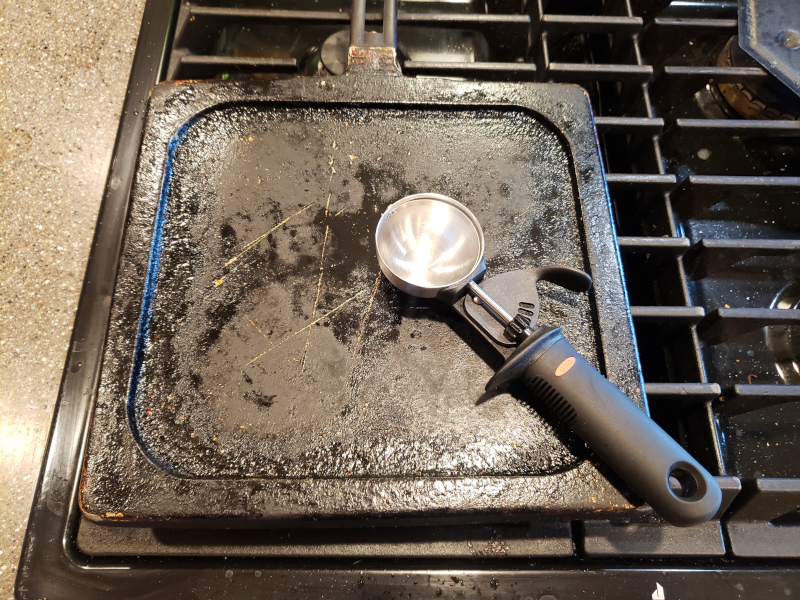
Ingredients
- 150 g all-purpose flour, or if you prefer, 75 g all-purpose flour and 75 g of strong (bread) flour
- 1/2 tsp salt
- 200 ml (200 g) lukewarm (90-105° F, 32-40° C) water
- a few more ml’s of lukewarm water, for activating the yeast
- 1/2 tsp sugar
- 1 tsp (about a half packet) dried yeast
- 1 tsp baking powder
- Canola oil for oiling the griddle and crumpet rings.
Preparation
- Preheat the toaster oven to Proof setting and 85° F (30° C).
- Using arubber spatula, mix flour, lukewarm water, and salt in a large mixing bowl.
- With a power mixer, beat the mixture for 2 minutes.
- In a small cup mix a few ml’s of lukewarm water with the sugar and yeast.
- Using a rubber spatula, mix the baking powder and the yeast mixture into the flour mixture.
- Beat the mixture for 1/2 minute with a power mixer.
- Cover the mixing bowl with cling-wrap and place in the preheated proofing oven for an hour – by that time it should have doubled in size.
- Using a rubber spatula, give the dough a few stirs, to remove the very largest bubbles.
- Heat a frying pan to medium-high (375° F, 190° C). This high heat converts the batter’s water to steam, which forms the all-important tubes of air in the crumpets.
- Using a brush and a bit of canola oil, lightly brush the pan and heavily brush the inside of the crumpet rings.
- Place the oiled rings in the frying pan.
- Pour batter in each crumpet ring – about 1/2” (1 cm) deep, from a scant 1/4 cup measure, or 64 ml ice cream scoop. Do not overfill, because a thick crumpet batter will be doughy and wet, won’t pull away from the sides of the rings, and will take forever to cook.
- When the tops of the crumpets are dry around the edge of the rings – at least 3 minutes, but it could be closer to 10– remove the hot rings using tongs. If they stick in places, they aren’t ready to come off – wait a while.
- Don’t lower the temperature, even though most recipes say to.
- Cook the crumpets until the bottoms are golden brown, about 10-15 minutes after pouring in, depending on how thick they are. The tops should be dry-ish and the sides should be visibly separating from the rings.
- Flip the crumpets and cook for a short time – a couple minutes – to brown the tops.
- Remove the crumpets to a cooling rack.
- Re-oil the crumpet rings, and repeat until the batter is gone.
- Freeze the cooled crumpets on the cooling rack, then stack the frozen crumpets in a bag in the freezer.
- To serve, thaw then toast each crumpet in a toaster, cover with jam, clotted cream, lemon curd, etc.

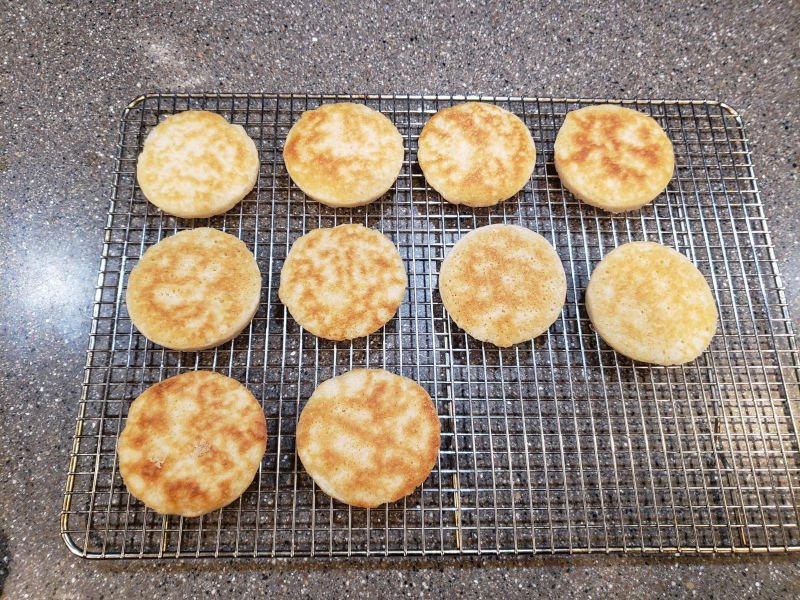
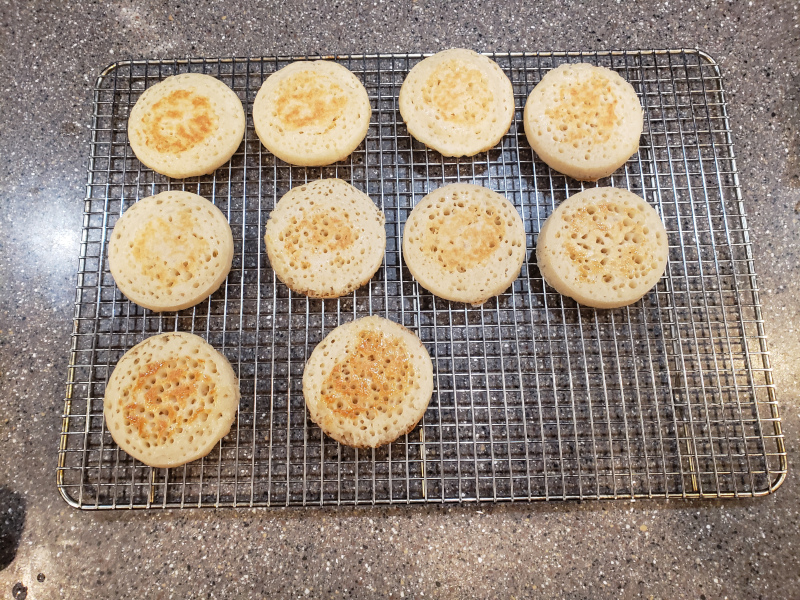

Good luck, and be patient with crumpets!
Corrections? Commiseration? Join the conversation about this post, on BlueSky.

